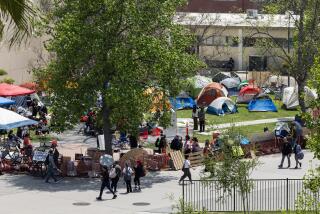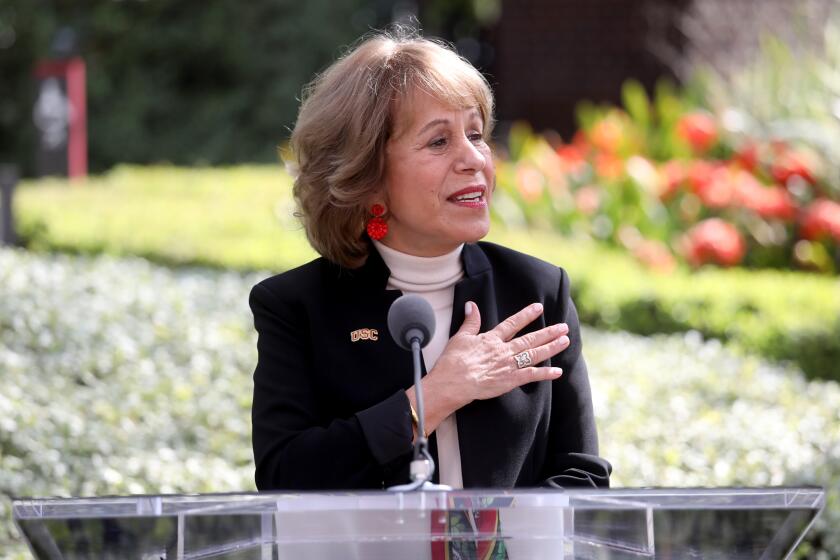College Quickly Harvests Ideas on Future
The timer clicked on, and Jeanne Cunningham didn’t waste a second. She was one of 125 people given five hours in all to plot the future of Glendale Community College. And she was having a real problem accepting point C-3.
“It has to go,” she said of the offending sentence--a recommendation that fraternities and sororities be established at the college.
With that, the first of five hourlong discussions at Table 4 had begun.
Cunningham--a professor of psychology at the 2-year school--was participating in a meeting that was something of a grass-roots planning adventure. It is called a charrette, and Glendale College officials had planned it as a way to get a large number of opinions on the direction of the college in a short time.
Charrettes-- intense critique and planning sessions that take their name from the French word for cart--are highly structured processes for making group decisions. They derive from the practice of 19th-Century French architecture students who, transported to their final exams in a cart, would use the time to discuss and critique each other’s ideas. Today, the word has evolved into a fast and stimulating way to involve a lot of people in a decision.
The meeting, attended by community leaders ranging from Glendale Mayor Carl Raggio to the president of the Glendale College freshman class, was the latest step in developing a plan for the educational future of the college. With a student body that has exploded in numbers and changed drastically in character in recent years, trustees decided a year ago that such a plan was needed.
Aided by a $25,000 federal grant, Glendale College officials have formed a committee to develop the plan and hope to complete it before the end of the year. The Nov. 9 event was an opportunity for community leaders to refine and improve the preliminary recommendations that the committee has developed.
Those recommendations addressed five areas of concern: the changing demographics of the student body, the diverse needs of students, the declining skills of entering students, the challenge of integrating new technology into the college program and the accountability of the college to government.
The participants gathered in the campus cafeteria to address such matters as diversity, elitism, ignorance and prejudice. Throughout the session, the participants came back to the same problem: Students today are entering Glendale College with poor English skills and often little knowledge of American culture, and the faculty is often ignorant of various cultural norms and thus insensitive to immigrant students.
Participants had some rather specific ideas to deal with those problems. Teachers, the participants agreed, must learn more about various cultures. At the same time, students should be offered more courses in basic English skills before studying advanced subjects. Participants at the charrette also suggested that the college offer more activities that would involve students in campus life.
The subjects were weighty, but some participants were amused to be part of such a large gathering of people seemingly talking at once. And with the timer in the front of the room keeping track of every second, they were talking fast.
“In my opinion, fraternities are elitist,” Cunningham was saying at Table 4, as one member of the 15-person group stood poised to write the group’s recommendations on an outsized note pad.
“I know what you’re saying, but my opinion is that frats and sororities make people want to come into this college and be more involved in it,” countered Todd Campbell, freshman class president.
“What is this point in here about setting up separate facilities for handicapped students?” college Trustee Rae Berry wanted to know at a table nearby. “I thought we were going away from segregation.”
“Wait, where is that? That must be a mistake,” Prof. Lynn McMurray said, looking frantically through his copy of the preliminary plan. But before he could find out, a microphoned voice intoned ominously: “You have 5 minutes to summarize where you are headed in your group.”
At a table by the window, the time constraints were not enough to prevent conversation from getting heated:
“Latinos lead the state in college dropouts,” Sal Castro, a counselor at Belmont High School, was saying. “I don’t know if you people know this, but we’re sending you gems. You’ve got to treat these students like crystal--very, very carefully.”
It was Don Averill’s idea to use the charrette process at Glendale College. The dean of career education had been part of charrettes run by consulting groups for private companies and said he thought it would be a perfect meeting format to use at the college.
At the end of each hour, each group shared its recommendations, and a committee, composed of one member from each, retired to another room to write up a report synthesizing the ideas of all the participants. The final reports were to go back to a college committee to be used to draw up a recommended 5-year plan that will be subject to approval of the college’s board of trustees.
“We’re putting everybody into this caldron of ideas as a way of saying, ‘Hey, are we on track?’ Because that’s what we’re here for; we’re here for the community,” Averill said.
More to Read
Start your day right
Sign up for Essential California for news, features and recommendations from the L.A. Times and beyond in your inbox six days a week.
You may occasionally receive promotional content from the Los Angeles Times.






